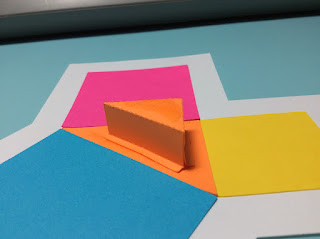The sum of the areas of the two squares on the legs (a and b) equals the area of the square on the hypotenuse (c).
The Pythagorean Theorem explains the relationship between the three sides of a right angle triangle. It states, "the area of the square whose side is the hypotenuse is equal to the sum of the areas of the squares on the other two sides." The Pythagorean theorem can be written mathematically as an equation, a2 + b2 = c2 , where a and b are the legs and c is the length of the hypotenuse.
Here is a video of the model.
Here is the PDF. I used 65 lb. cardstock and an acrylic sheet.
Here is the .Studio file.
Here is the SVG. The file extends beyond the scope of the viewing field. Zoom out to see the entire file.
Here are directions from a previous blog posting that show how to make the frame sides.
Crease and apply glue to the tab as shown above for the side piece with the wing tabs. Flatten the piece to adhere the glue. Form the piece into a block.
Crease the sides of the piece without the wing tabs. Apply glue to the tab as before. Adhere the glue by pressing down on the side piece to flatten it. Once the glue is adhered, form the piece into a block.
Apply glue to the wing tabs. Insert the tabs into the side without the winged tabs.
Make the Pythagorean Theorem Model
Glue the squares and triangle onto the backing. Make a 3 dimensional triangle and glue the sides down to the center of the base triangle.
Glue the sides of the model to its base
Glue the second triangle to the center of the 3D triangle. Attach the acetate to top and tape the sides. Remove the acetate.










I love this! I have been looking for a tactile manipulative for this. Do you have others for different math concepts?
ReplyDelete